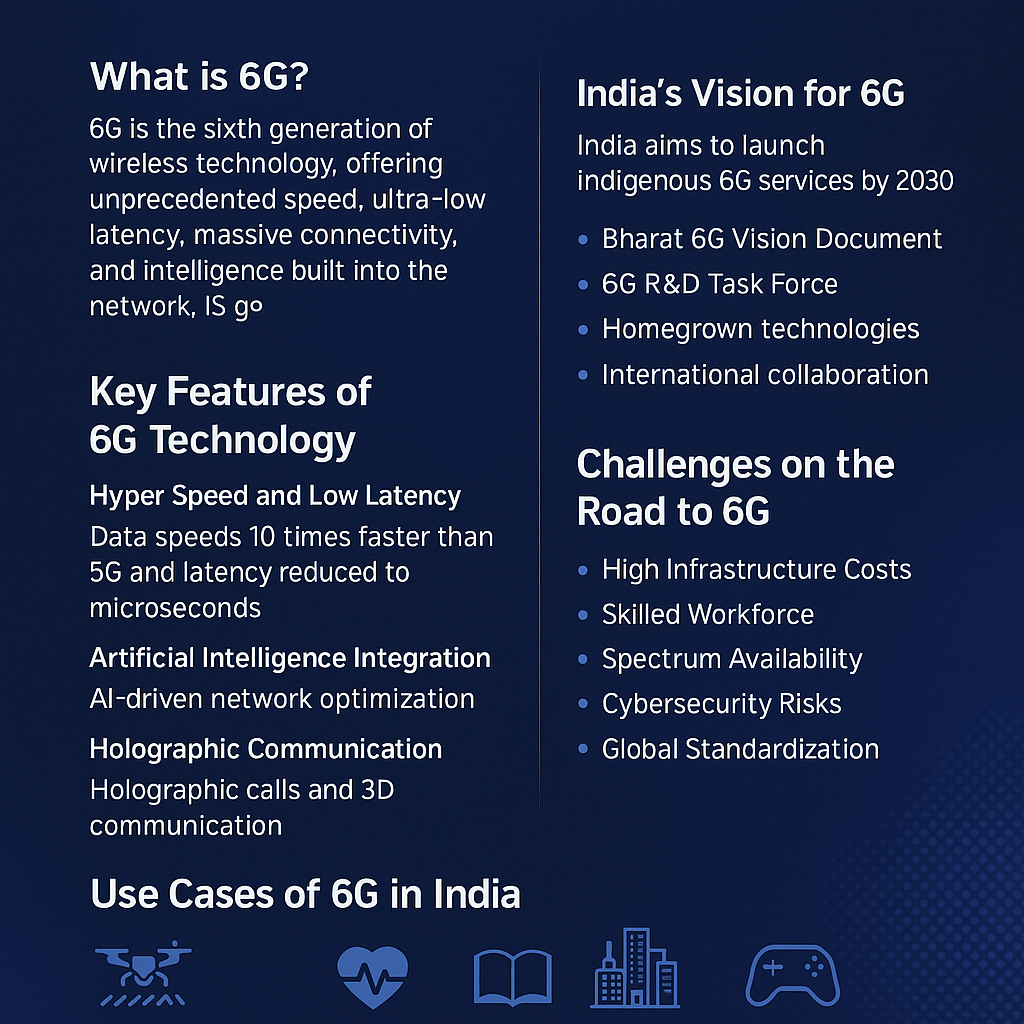India is preparing for a technological revolution that will reshape how people connect, work, and innovate. While 5G has just begun to roll out in many regions of the country, the buzz around 6G is already making headlines. India, known for its rapid digital adoption and homegrown technological talent, is aiming to play a key role in developing and deploying 6G technology by the year 2030.
In this blog, we’ll explore what 6G is, how it’s different from 5G, India’s plans and strategy, the challenges involved, and the massive potential it holds for sectors like healthcare, agriculture, education, and smart cities.
What is 6G?
6G, or the sixth generation of wireless technology, is expected to offer unprecedented speed, ultra-low latency, massive connectivity, and intelligence built right into the network. While 5G provides speeds up to 10 Gbps, 6G may go beyond 100 Gbps, with latency dropping to less than 1 millisecond.
But 6G isn’t just about faster internet—it’s about seamless integration of digital and physical worlds. Technologies like Artificial Intelligence (AI), Machine Learning (ML), Extended Reality (XR), and terahertz (THz) frequency bands will become native components of communication networks.
Key Features of 6G Technology
Here are some of the core features that make 6G revolutionary:
1. Hyper Speed and Low Latency
6G aims to provide data speeds 10 times faster than 5G. Latency will be reduced to microseconds, enabling real-time communication for mission-critical applications.
2. Artificial Intelligence Integration
6G will have AI-driven network optimization, security, and traffic management. The network will learn, adapt, and predict user behavior.
3. Holographic Communication
Holographic calls and 3D communication will become possible, transforming telepresence and entertainment experiences.
4. Internet of Everything (IoE)
6G will move from Internet of Things (IoT) to Internet of Everything, where not just devices but objects, environments, and even people will be interconnected.
5. Energy Efficiency and Sustainability
6G networks are being designed with sustainability in mind, consuming less energy per bit and supporting green infrastructure.
India’s Vision for 6G
India’s ambition to become a global technology leader is backed by strategic initiatives and collaborations. The Government of India released the Bharat 6G Vision Document in March 2023, outlining a roadmap to launch indigenous 6G services by 2030.
📌 Key Points from the Bharat 6G Vision:
- 6G R&D Task Force formed under the Department of Telecommunications (DoT).
- Focus on homegrown technologies and international collaboration.
- Development of secure, affordable, and reliable 6G solutions for both rural and urban India.
- Emphasis on spectrum management, hardware innovation, and test beds.
Major Players in India’s 6G Ecosystem
India’s 6G journey is being powered by collaboration between government, academia, and industry.
🏢 Government:
- Department of Telecommunications (DoT)
- Telecom Regulatory Authority of India (TRAI)
- ISRO (for satellite-based 6G applications)
- MeitY (Ministry of Electronics and Information Technology)
🏫 Academia:
- IIT Madras, IIT Delhi, IIT Hyderabad, and IISc Bengaluru are leading research on terahertz, AI integration, and secure communications.
🏭 Industry:
- Reliance Jio and Bharti Airtel are investing in 6G R&D.
- Tata Consultancy Services (TCS) and Tech Mahindra are exploring software-driven 6G architecture.
- Startups in Bangalore, Hyderabad, and Pune are developing advanced chipsets and radio modules.
International Collaborations
India is actively engaging in global discussions to shape the future of 6G. The country has joined international bodies such as:
- International Telecommunication Union (ITU)
- Next G Alliance (USA)
- 6G Flagship (Finland)
- European Union’s Hexa-X project
These partnerships help India align its 6G standards with global protocols and promote mutual innovation.
Use Cases of 6G in India
🚜 1. Agriculture
Smart sensors and drones connected through 6G can provide real-time soil analysis, pest detection, and weather alerts. Farmers will be able to remotely monitor and control equipment, enhancing productivity.
🏥 2. Healthcare
Remote robotic surgeries, real-time patient monitoring, and AI diagnosis will become more accurate and widespread. Patients in remote areas can receive expert care without traveling.
🏫 3. Education
6G-enabled immersive classrooms using augmented and virtual reality will provide quality education even in rural zones, bridging the urban-rural learning divide.
🏙️ 4. Smart Cities
Traffic control, waste management, pollution monitoring, and energy usage will be optimized with connected devices powered by high-speed 6G networks.
🚗 5. Autonomous Vehicles
Self-driving cars and drones will communicate with each other and with infrastructure in real-time, reducing accidents and improving logistics.
🎮 6. Entertainment & Gaming
Ultra-HD streaming, holographic concerts, and cloud gaming with zero lag will redefine digital entertainment.
Challenges on the Road to 6G
While the future is promising, several challenges must be addressed:
⚙️ 1. High Infrastructure Costs
Building a nationwide 6G infrastructure will require huge capital investments, particularly in rural areas.
🧠 2. Skilled Workforce
India needs to train engineers and researchers in advanced fields like terahertz communication, quantum computing, and AI/ML for telecom.
🛰️ 3. Spectrum Availability
Efficient allocation and management of high-frequency spectrum (like THz) is crucial. Policies must balance innovation with regulation.
🔐 4. Cybersecurity Risks
More connected devices mean more entry points for cyberattacks. India must develop robust encryption, AI-based threat detection, and secure hardware.
🌐 5. Global Standardization
India needs to be proactive in contributing to global 6G standards, or risk becoming dependent on foreign technology.
India’s Strategy to Overcome Challenges
To tackle the hurdles, India has adopted a multi-pronged approach:
✅ Investment in Research & Innovation
The government has sanctioned funding for 6G labs, test beds, and public-private partnerships.
✅ Indigenous Manufacturing
Programs like Make in India and PLI (Production Linked Incentive) schemes are encouraging local production of telecom equipment and semiconductors.
✅ Policy Support
TRAI and DoT are working on spectrum auctions, regulations for satellite internet, and incentives for startups.
✅ International Cooperation
India is partnering with global players to exchange ideas, ensure compatibility, and fast-track innovation.
When Will 6G Arrive in India?
The expected timeline for India’s 6G rollout is between 2029 and 2031. The country aims to have pilot deployments and limited commercial use by 2029, with widespread adoption to follow by 2031.
Given India’s success with 4G penetration and rapid 5G rollout in metro cities, there is high optimism that 6G will also reach rural and underserved areas faster than before.

